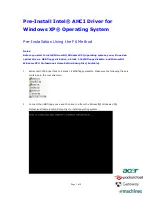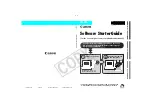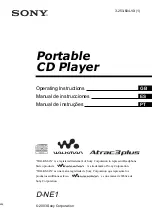
You do not need to enable NAT-T for your internal security device nodes that use NAT;
each VPN node knows the correct address translations for VPN traffic and does not
need to encapsulate the traffic.
To use NAT-T, enable NAT-Traversal and specify:
•
UDP Checksum. A 2-byte value (calculated from the UDP header, footer, and other
UDP message fields) that verifies packet integrity. You must enable this option for
NAT devices that require UDP checksum verification; however, most NAT devices
(including security devices) do not require it.
•
Keep alive Frequency. The number of seconds a VPN node waits between sending
empty UDP packets through the NAT device. A NAT device keeps translated IP
addresses active only during traffic flow, and invalidates unused IP addresses. To
ensure that the VPN tunnel remains open, you can configure the VPN node to send
empty "keep alive” packets through the NAT device.
IKE IDs/XAuth
Every VPN member has a unique identification number, known as an IKE ID. During Phase
1 negotiations, the IKE protocol uses the ID to authenticate the VPN member. You must
select and configure an ID type for the VPN members at each end of the tunnel. However,
the ID type can be different for each member:
•
ASN1-DN—Abstract Syntax Notation, version 1 is a data representation format that is
non-platform specific; Distinguished Name is the name of the computer. Use ASN1-DN
to create a Group ID that enables multiple RAS users to connect to the VPN tunnel
concurrently.
•
At the peer ID, specify values for the Container Match and Wildcard Match.
•
At the local ID, specify the value.
Using a Group ID can make configuring and maintaining your VPN quicker and easier.
For details on how Group IKE IDs work, see “Configuring Group IKE IDS” on page 557.
For details on determining the ASN1-DN container and wildcard values for Group IKE
IDs, see the documentation for your version of ScreenOS.
•
FQDN—Use a Fully Qualified Domain Name when the VPN member uses a dynamic
IP address. FQDN is a name that identifies (qualifies) a computer to the DNS protocol
using the computer name and the domain name; ex. server1.colorado.mycompany.com.
•
IP Address—Use an IP address when the VPN member uses a static IP address.
•
U-FQDN—Use a User Fully Qualified Domain Name when the VPN member uses a
dynamic IP address (such as a RAS user). A U-FQDN is an e-mail address, such as
[email protected].
Use the XAuth protocol to authenticate RAS users with an authentication token (such
as SecureID) and to make TCP/IP settings (IP address, DNS server, and WINS server)
for the peer gateway.
Copyright © 2010, Juniper Networks, Inc.
596
Network and Security Manager Administration Guide
Summary of Contents for NETWORK AND SECURITY MANAGER 2010.3
Page 6: ...Copyright 2010 Juniper Networks Inc vi...
Page 36: ...Copyright 2010 Juniper Networks Inc xxxvi Network and Security Manager Administration Guide...
Page 52: ...Copyright 2010 Juniper Networks Inc 2 Network and Security Manager Administration Guide...
Page 90: ...Copyright 2010 Juniper Networks Inc 40 Network and Security Manager Administration Guide...
Page 144: ...Copyright 2010 Juniper Networks Inc 94 Network and Security Manager Administration Guide...
Page 146: ...Copyright 2010 Juniper Networks Inc 96 Network and Security Manager Administration Guide...
Page 234: ...Copyright 2010 Juniper Networks Inc 184 Network and Security Manager Administration Guide...
Page 310: ...Copyright 2010 Juniper Networks Inc 260 Network and Security Manager Administration Guide...
Page 364: ...Copyright 2010 Juniper Networks Inc 314 Network and Security Manager Administration Guide...
Page 366: ...Copyright 2010 Juniper Networks Inc 316 Network and Security Manager Administration Guide...
Page 478: ...Copyright 2010 Juniper Networks Inc 428 Network and Security Manager Administration Guide...
Page 576: ...Copyright 2010 Juniper Networks Inc 526 Network and Security Manager Administration Guide...
Page 580: ...Copyright 2010 Juniper Networks Inc 530 Network and Security Manager Administration Guide...
Page 592: ...Copyright 2010 Juniper Networks Inc 542 Network and Security Manager Administration Guide...
Page 684: ...Copyright 2010 Juniper Networks Inc 634 Network and Security Manager Administration Guide...
Page 690: ...Copyright 2010 Juniper Networks Inc 640 Network and Security Manager Administration Guide...
Page 696: ...Copyright 2010 Juniper Networks Inc 646 Network and Security Manager Administration Guide...
Page 698: ...Copyright 2010 Juniper Networks Inc 648 Network and Security Manager Administration Guide...
Page 748: ...Copyright 2010 Juniper Networks Inc 698 Network and Security Manager Administration Guide...
Page 778: ...Copyright 2010 Juniper Networks Inc 728 Network and Security Manager Administration Guide...
Page 870: ...Copyright 2010 Juniper Networks Inc 820 Network and Security Manager Administration Guide...
Page 872: ...Copyright 2010 Juniper Networks Inc 822 Network and Security Manager Administration Guide...
Page 898: ...Copyright 2010 Juniper Networks Inc 848 Network and Security Manager Administration Guide...
Page 908: ...Copyright 2010 Juniper Networks Inc 858 Network and Security Manager Administration Guide...
Page 910: ...Copyright 2010 Juniper Networks Inc 860 Network and Security Manager Administration Guide...
Page 995: ...PART 6 Index Index on page 947 945 Copyright 2010 Juniper Networks Inc...
Page 996: ...Copyright 2010 Juniper Networks Inc 946 Network and Security Manager Administration Guide...
















































